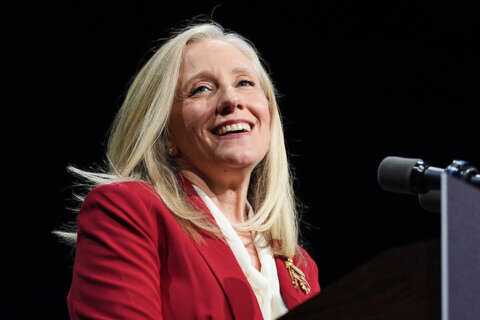ARLINGTON, Va. — A majority of Virginians oppose removing statues of Confederate leaders, according to a recent Mason-Dixon Polling survey.
Most Northern Virginians, however, support removing the statues.
“Northern Virginia is very different from the rest of the state,” University of Mary Washington political science professor Stephen Farnsworth told WTOP.
The Northern Virginia region — as defined by the survey as containing Arlington, Fairfax, Loudoun and Prince William counties and the cities of Alexandria, Fairfax, Falls Church, Manassas and Manassas Park — supports removing the statues by 43 to 40 percent.
The state overall opposes the idea by a 52 to 35 percent.
“I think it’s going to be a challenge for the Democratic candidates to deal with the statues issue if it becomes a topic throughout the campaign,” Farnsworth said.
Democrats nationally have been voicing their strong support for removing Confederate statues, with cities such as Baltimore, New Orleans and Dallas taking action to remove statues.
In Virginia, 59 percent of Democrats support removal — though one in five aren’t sure on the issue. Republicans are far more certain in their stance, as 79 percent say they oppose the idea, compared with the 16 percent who support their removal and 5 percent who are uncertain.
However, independent voters also largely oppose their removal. The poll found that 62 percent of those voters oppose the idea of removing the statues, while roughly a quarter support it.
Along racial lines, 58 percent of white voters are against removing Confederate statues, while 57 percent of black voters support it.
“It’s going to be a challenge for the Democrats to put forward something that’s going to keep African-American voters happy at the same time that others don’t see it as disrespecting heritage of their own,” Farnsworth stated.
His recommendation for Democrats is to find a new topic to focus on.
“Something along the lines of education or economic development or transportation in Northern Virginia — any one of these issues are likely to be more useful for a conversation that would help Democrats win a swing voter than to talk about the statues,” said Farnsworth. “You can understand, though, on the other side why Republicans would want to talk about this topic because the idea of leaving things more or less as they are has majority support and that’s the Republican position.”
The state as a whole was even more against the idea of removing monuments for Confederate units and common soldiers, by 62 to 24 percent.
Northern Virginia also opposed that idea, but by a narrower 46 to 32 percent.
“One of the things to remember about Virginia is that an awful lot of people have come to Virginia from somewhere else, and so they may not have the values and conservative views with respect to these monuments that you may have seen in Virginia 20 or 30 years ago,” Farnsworth said. “It’s a very rapidly changing state and for some voters, this is simply not going to be a matter of personal pride.”
The governor’s race
For the gubernatorial race, the poll had the race close, with Democrat Ralph Northam slightly ahead of Republican Ed Gillespie by a 44 to 43 margin.
“I think the biggest challenge that both candidates for governor are facing is how to be heard in the age of Donald Trump,” the professor stated. “President Trump has really taken so much media attention this past year that these candidates for governor have not really had much of a chance to be heard unless they talk in some way about something Donald Trump is already talking about.”
Farnsworth says that’s in stark contrast to the last Virginia gubernatorial race: “Ken Cuccinelli and Terry McAuliffe were very, very visible and aggressive campaigners who had a lot of opportunities to be heard.”
Northam said in the Sept. 19 debate that these monuments allow groups such as the white nationalists seen in Charlottesville last month to “spew hatred and bigotry.” He argued that local communities should decide what to do with them.
Gillespie said at that same debate that the monuments should be kept in place, but supports the idea of more context and more statues honoring more recent civil rights leaders.
Voters support adding context to statues by a 54-to-32 percent margin — roughly an equal margin across all regions of the state. Independent voters and Republicans were more likely to support that idea than Democrats.
Also, 55 percent of likely voters also say that Confederate monuments are an important part of history.
That compares with 37 percent who say that Confederate monuments glorify racism and resistance to civil rights.
Only Northern Virginia had a majority of respondents say the monuments represented racism.
When it comes to paying to remove these statues, two-thirds of Virginians say it is a bad use of government money. About 55 percent in Northern Virginia said the same.
If a local government wants to move a statue, 60 percent of respondents say, they have the obligation of paying for it.
Divisions
The growing split in opinions on state values such as Confederate statues, Farnsworth said, just creates more of a challenge for the two parties to win in the areas where they are in the minority.
“You are looking at a traditional pattern that is getting more and more extreme in every election,” Farnsworth said. “There are more advantages for Democrats in Northern Virginia, more advantages for Republicans in the rural part of the state.”
For this coming election, Farnsworth says Democrats will need to crank up the turnout in Northern Virginia, and Republicans will try to do the same for everyone living south of the Occoquan and west of I-95.
As for the president’s impact on this election, the political scientist says there is one place to look.
“A number of House of Delegates races in Prince William County … that’s going to be where you are going to see the challenge for Republican incumbents dealing with an electorate that is split, because Prince William County is one of key swing counties in Virginia these days.”
The Mason-Dixon Polling survey questioned 625 registered Virginia voters. The margin of error is plus or minus four percentage points.







